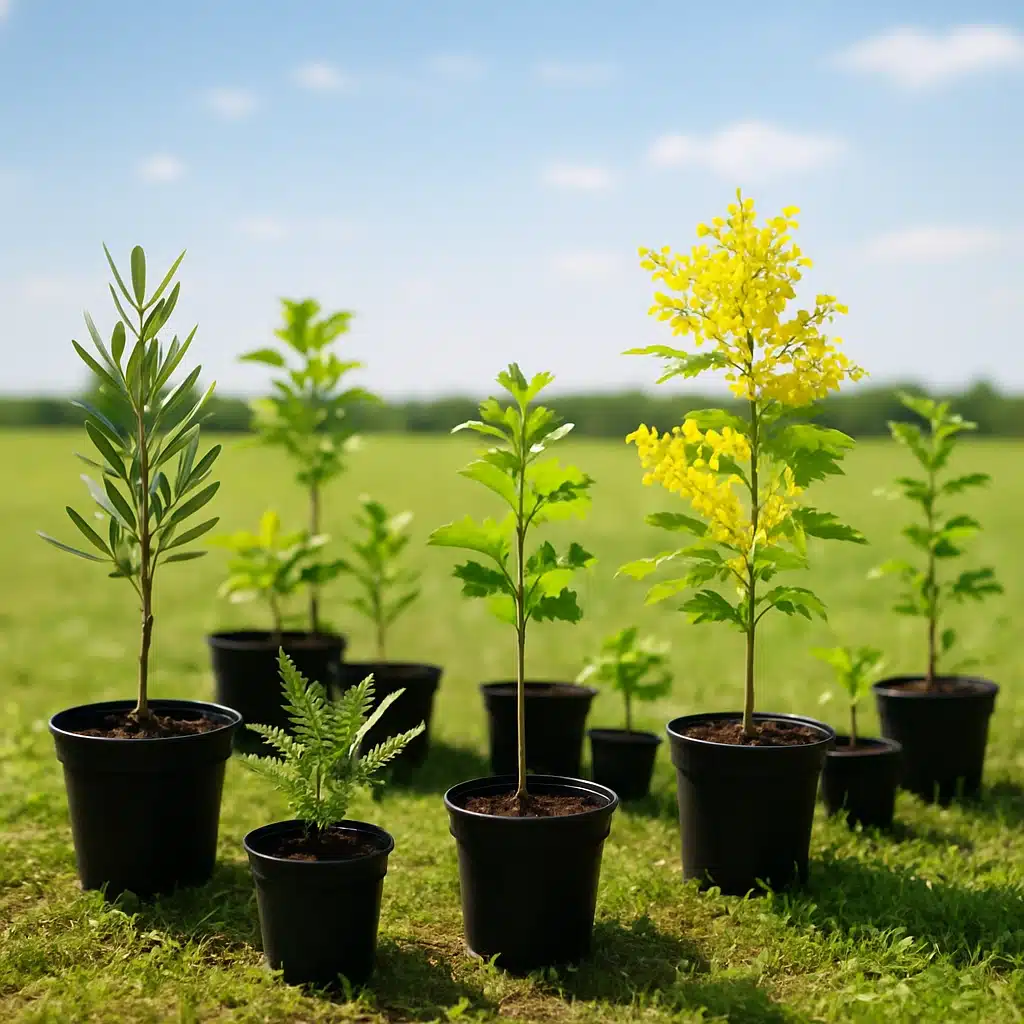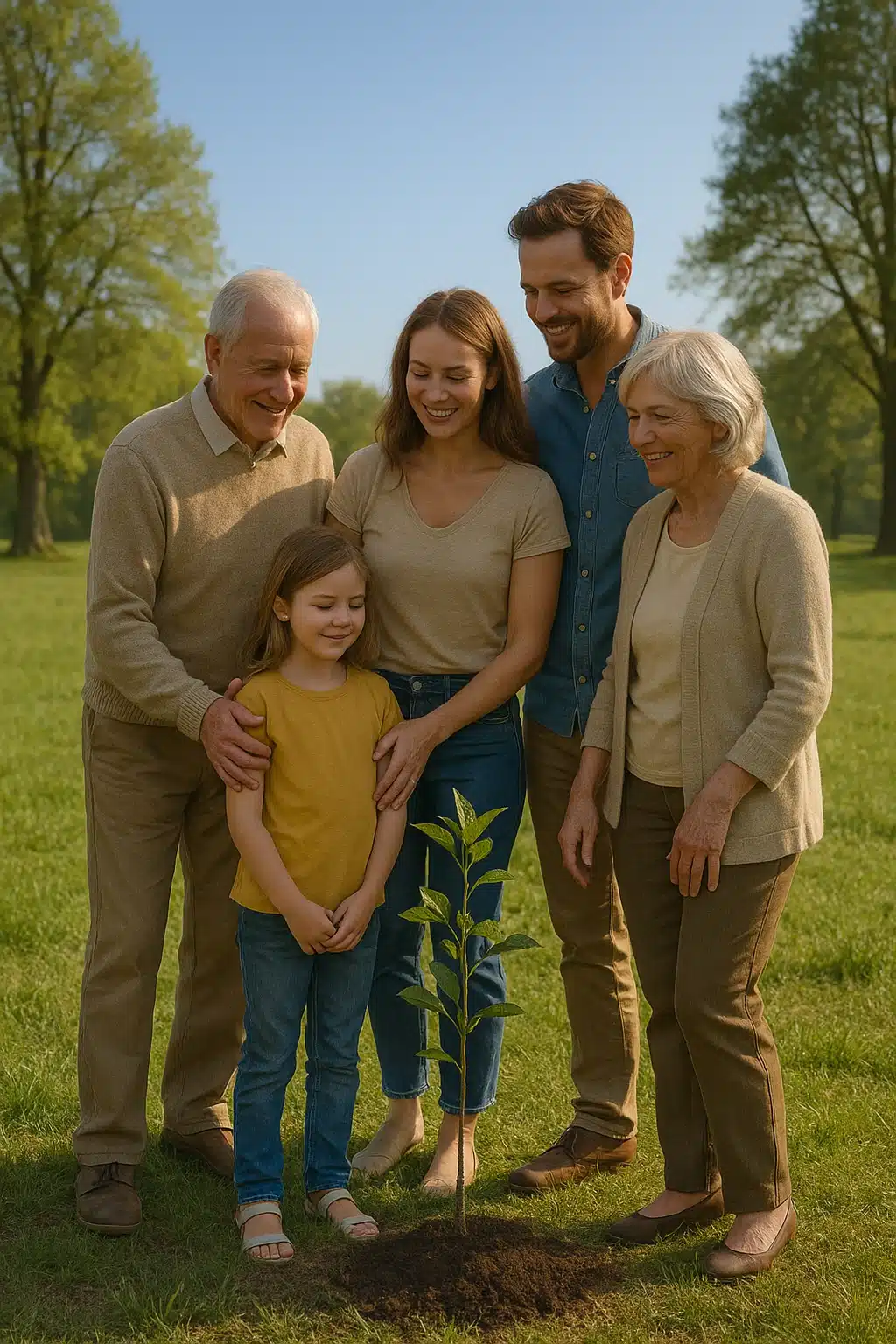An eco-friendly urn to create a living tribute
The result of research and testing, our unique planting system using a medium-term biodegradable cork urn is one of the most advanced solutions available today for honoring the cycle of life.
Simply place the ashes in the urn, then insert the sliding cap, called the Separation, which seals and protects the ashes while gradually regulating access to the roots.
Then, plant a young tree inside the urn and bury the entire unit.
From the first year, the roots will draw from the ashes.
From the second year, the roots will naturally penetrate the cork walls and extend into the soil.
After six years, the urn will naturally decompose to become compost, enriching both the soil and the tree.
Burying a biodegradable urn in the ground = an act of scattering.
To change the world, let’s start by changing our perspective on death and therefore on Life

Step 1
Choose the size of the urn & Add a message
If you wish, Write us your message, which we will print around the urn.You can also use a marker to handwrite your message.
Once you receive your urn, hand it over to the crematorium, or place the ashes yourself directly into the urn, and position the separation pièce on top. This will seal and protect the ashes while regulating root access.
Step 1
Choose the size of the urn & Add a message
If you wish, Write us your message, which we will print around the urn.
You can also use a marker to handwrite your message.
Once you receive your urn, hand it over to the crematorium, or place the ashes yourself directly into the urn, and position the separation pièce on top. This will seal and protect the ashes while regulating root access.

Step 2
Choose the sapling or plant
Visit your favorite nursery to choose the young tree or plant of your choice.
Two important criteria must be met:
Compatibility with the climate and vegetation of the place where you will bury the urn, and the symbolism that best represents the personality of the deceased.
For example, if you live in a warm and sunny region, a bougainvillea will be perfect for a medium or large urn and will bloom for six months of the year.
Refer to our tree symbolism.

Step 3
Plant the tree and hold a farewell ceremony.
This symbolic moment can become a meaningful step in the grieving process. Planting the tree in the urn, surrounded by loved ones, offers an opportunity to create an intimate, gentle, and deeply meaningful ceremony. Some may choose a simple ritual, while others may prefer the guidance of a funeral planner to help design a unique and personalized tribute.
Step 3
Plant the tree and hold a farewell ceremony.
This symbolic moment can become a meaningful step in the grieving process. Planting the tree in the urn, surrounded by loved ones, offers an opportunity to create an intimate, gentle, and deeply meaningful ceremony. Some may choose a simple ritual, while others may prefer the guidance of a funeral planner to help design a unique and personalized tribute.
Step 4
Bury the urn
Once the tree is planted in the urn, the next step is burial — a powerful and symbolic moment. Two options are available, depending on your preferences and circumstances.
The first option is to place the urn in a suitably sized pot. It can be kept indoors or outdoors — in a garden, on a terrace or indoors.
The second option is to bury the urn directly in the ground, in a private garden, a forest, or in a place specifically dedicated to remembrance, such as a natural cemetery, a memorial forest, or a designated burial site.
This act of burial carries deep symbolic meaning: it represents the release of the soul and a gentle letting go. It is a gesture of love and trust — allowing the spirit to be free.

Step 5
Let time do its work
Once the tree is planted, all that remains is to let time do its work… Nature, with quiet determination, will weave its magic. Roots will anchor into the soil, leaves will reach for the sky, and the tree will grow.
This slow, beautiful transformation symbolizes the continuity of life and takes on new forms. The tree becomes a bridge between what was and what will be, between remembrance and renewal.
This simple gesture carries a powerful message of hope. It invites us to see death differently — not as an end, but as a transition toward something living.
For those who remain, it is also an invitation to live fully, with gratitude. Because perhaps this is the true secret of a meaningful life: to honor those we love by living our own life with peace and intensity.
A Natural Way to Scatter Ashes with Meaning
Step 5
Let time do its work
Once the tree is planted, all that remains is to let time do its work… Nature, with quiet determination, will weave its magic. Roots will anchor into the soil, leaves will reach for the sky, and the tree will grow.
This slow, beautiful transformation symbolizes the continuity of life and takes on new forms. The tree becomes a bridge between what was and what will be, between remembrance and renewal.
This simple gesture carries a powerful message of hope. It invites us to see death differently — not as an end, but as a transition toward something living.
For those who remain, it is also an invitation to live fully, with gratitude. Because perhaps this is the true secret of a meaningful life: to honor those we love by living our own life with peace and intensity.

A natural and meaningful way to scatter ashes
Where to Bury the Urn with the Tree?
Planting a Tree Urn is a beautiful way to honor a loved one while contributing to environmental preservation.
Each country has its own legislation, but generally speaking, since TREE-URN is a biodegradable urn, it falls into the category of urns for scattering ashes.
We invite you to consult our guide to the legislation of each country, in Europe, the USA and Canada.
Why to choose a young Tree?
Choosing a young tree instead of a seed is a strategic decision.
Ashes provide useful mineral elements to plants, mainly calcium, potassium, magnesium, phosphorus and trace elements and are therefore an excellent natural fertilizer. However, ashes have a high alkaline pH, generally between 10 and 12, which makes them incompatible with seeds or seedlings.
Partition Regulation System: Our regulation system, ensured by the Partition piece, offers several technical advantages:
1. Progressive Water Drainage:
- Water gradually flows from the upper part of the roots to the lower part containing the ashes.
- Water acts as a reactive agent, reducing the pH of the ashes by dissolving the alkaline ions present in them.
- Then, the water drains from the base of the urn into the soil, gradually carrying away the excess alkalinity.
2. Progressive Access to Ashes:
- The Partition regulation system ensures the roots have progressive access to the ashes over several months.
- This regulation prevents an excess of natural fertilizer, thereby avoiding any risk of the tree wilting.
3. Soil pH Correction:
- If, as your plants grow, you notice an abnormal increase in yellowed leaves, this may indicate that the soil still has a high alkaline pH. To rebalance the pH of the ashes, it is recommended to water abundantly for a few days.

